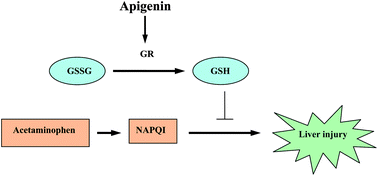Protective effect of apigenin on mouse acute liver injury induced by acetaminophen is associated with increment of hepatic glutathione reductase activity
Abstract

* Corresponding authors
a
Department of Pharmacology, College of Pharmaceutical Sciences, Soochow University, Suzhou 215123, Jiangsu Province, China
E-mail:
xiemeilin@suda.edu.cn
Fax: +86-512-65880103
Tel: +86-512-69566553
b Suzhou Institute of Chinese Materia Medica, Soochow University, Suzhou 215123, Jiangsu Province, China

 Please wait while we load your content...
Something went wrong. Try again?
Please wait while we load your content...
Something went wrong. Try again?
J. Yang, X. Wang, J. Xue, Z. Gu and M. Xie, Food Funct., 2013, 4, 939 DOI: 10.1039/C3FO60071H
To request permission to reproduce material from this article, please go to the Copyright Clearance Center request page.
If you are an author contributing to an RSC publication, you do not need to request permission provided correct acknowledgement is given.
If you are the author of this article, you do not need to request permission to reproduce figures and diagrams provided correct acknowledgement is given. If you want to reproduce the whole article in a third-party publication (excluding your thesis/dissertation for which permission is not required) please go to the Copyright Clearance Center request page.
Read more about how to correctly acknowledge RSC content.
 Fetching data from CrossRef.
Fetching data from CrossRef.
This may take some time to load.
Loading related content
